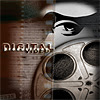Ah, here's something for those a little green about the knowledge of making films digitally:
Digital film making is the process of capturing motion pictures as digital images, rather than on film. Digital capture may occur on tape, hard disks, flash memory, or other media which can record digital data.
Digital film making captures motion pictures digitally, in a process analogous to digital photography. While there is no clear technical distinction that separates the images captured in digital cinematography from video, the term "digital cinematography" is usually applied only in cases where digital acquisition is substituting for film acquisition, such as when shooting a feature film. The term is not generally applied when digital acquisition is substituting for analog video acquisition, as with live broadcast television programs.
Digital vs. Film
1.When shooting on film, response to light is determined by what film stock is chosen. A cinematographer can choose a film stock he or she is familiar with, and expose film on set with a high degree of confidence about how it will turn out. Because the film stock is the main determining factor, results will be substantially similar regardless of what camera model is being used.In contrast, when shooting digitally, response to light is determined by the CMOS or CCD sensor(s) in the camera, and every camera is different. A cinematographer shooting digitally can at once measure and monitor the final result and outcome, without waiting for the result from the developed film.
2.Although very compact and inexpensive digital cameras are becoming more widely available, the image quality is not yet up to the level normally desired for theatrical release. High-end digital cinema cameras tend to be quite large, and some models require bulky external recording mechanisms (though in some cases only a small strand of optical fiber is necessary to connect the camera and the recording mechanism).
In contrast, there are compact 35mm film cameras that produce the full 35mm film resolution and accept standard 35mm lenses
3.Digital acquisition typically offers better performance than film in low-light conditions, allowing less lighting and in some cases completely natural or practical lighting to be used for shooting, even indoors. This low-light sensitivity also tends to bring out shadow detail. Some directors have tried a "best for the job" approach, using digital acquisition for indoor or night shoots, and traditional film for daylight exteriors.
4.Films are traditionally shot with dual-system recording, where picture is recorded on camera, and sync sound is recorded to a separate sound recoding device. In post-production, picture and sound are synced up.
Many cameras used for digital cinematography can record sound internally, already in sync with picture. This eliminates the need for syncing in post, which can lead to faster workflows.
Today, digital acquisition accounts for the vast majority of moving image acquisition, as most content for broadcast is shot on digital formats. Most movies destined for theatrical release are still shot on film, however, as are many dramatic TV series and some high-budget commercials. High-end digital cinematography cameras suitable for acquiring footage intended for theatrical release are on the market since 1999/2000, and have meanwhile gained widespread adoption.
Some notable high-profile directors that have shot with digital equipment include
Sidney Lumet - Before the Devil Knows You're Dead
Andy Wachowski and Larry Wachowski - Speed Racer
Bryan Singer - Superman Returns
Mel Gibson - Apocalypto
David Fincher - Zodiac
Michael Mann - Miami Vice, Collateral
Steven Soderbergh - Guerrilla
Francis Ford Coppola - Youth Without Youth
George Lucas - Star Wars Episode II and III,
Robert Altman - A Prairie Home Companion
Anthony Hopkins - Slipstream
Robert Rodriguez - Sin City, Grindhouse
Lars von Trier - Dogville, Manderlay
David Zucker - Scary Movie 4
Michael Moore - Bowling for Columbine
Sylvester Stallone - Rocky Balboa
Peter Jackson - Crossing the line
David Lynch - Inland Empire
Lee Tamahori - Next
James Cameron - Ghosts of the Abyss, Aliens of the Deep
Tony Scott - Déjà Vu
Jean-Jacques Annaud - Two Brothers
Tim Burton - Corpse Bride
Some of these directors are strong supporters of the change from film to digital, some of them declare that it depends on the particular movie.
Monday, November 5, 2007
Subscribe to:
Post Comments (Atom)




No comments:
Post a Comment